Chirashi is a nutritious, tasty, beautiful sushi dish , but did you know you can make them at home? Here’s how to make a chirashi bowl - and how to make keto chirashi, as well!
Note: This recipe was first posted on my original blog, Celebration Generation, on September 12, 2020. It was transferred over to this blog - existing comments and all - on 9/27/2021. Updated on 11/18/2022.

Well, today I’ve got our “How to Make a Chirashi Bowl” recipe - well, more like guidelines - and I’ve got another poke bowl coming up in a bit!
We’ve been eating a LOT of raw fish lately, as a result of a couple of circumstances:
1. A new sushi restaurant opened up about 10 minutes from our house, that offers cheap and GOOD sushi for takeout.
2. Our Skipper Otto Community Supported Fishery membership ended up with us getting *the* most amazing sushi-grade albacore tuna I’ve ever had in my life.
Like some other things in life, the more sushi you get, the more you want... IMHO.
While we love sushi rolls, we like to change it up every once in a while and go for a fish bowl - either as a poke bowl (ALSO available very close to us!) or or an awesome chirashi bowl.
Keto Chirashi
Unfortunately, that local sushi restaurant that we love doesn’t offer chirashi bowl as a menu item at all... much less any kind of keto chirashi bowl .. And I need to go low carb for a while.
Like so much Japanese cooking, this style of sushi is made up almost entirely of healthy foods as it is.
Adapting it slightly to accommodate my keto diet needs for weight loss... really didn’t take much tweaking.
So. Homemade Keto Chirashi Bowl FTW!
This post covers both keto and non-keto (traditional) options, making it easy to serve this dish for everyone in your family, regardless of dietary restrictions!
What is a Chirashi Bowl?
Just like nigiri sushi or maki sushi, a Chirashi bowl - AKA bara chirashi, Chirashizushi, Gomoku sushi, Gomoku chirashi, chirashi don, or kaisen don - is basically traditional style of Japanese sushi ... only it’s in bowl form.
Charashi is a Japanese word, meaning “Scattered”. As in, a bowl of rice with scattered sushi toppings on top!
Generally speaking, any chirashi sushi you order in a restaurant won’t actually involve much scattering.
In my experience, it’s more about artfully - even lovingly? - arranging the fish and toppings on the rice bowl.
“Scattering” implies something far more chaotic than the dish you’re presented with, IMHO!
Chirashi vs Poke
Poke
As I detailed in my recent Tuna Mango Poke Recipe, Poke is a Hawaiian thing - small chunks of raw fish that have been marinated, served over rice.
The cooked rice used will be either sushi rice or plain rice.
Generally speaking, it’ll be a single type of fish.
Sometimes it’s an appetizer, sometimes it’s a meal. When it’s a meal, you’re likely to see vegetables involved alongside the tiny pieces of fish and rice.
At the local poke bowl place, the list of vegetables and other accoutrements available is impressive, though we like to keep it relatively simple when making it at home.
Chirashi
While Poke has Japanese influence, it’s definitely a Hawaiian thing - Chirashi is a Japanese meal.
Chirashi fish is sliced and presented in much the same way it would be on a sashimi tray, rather than cut into small pieces.
Additionally, the fish in a chirashi bowl isn’t marinated before arranging it on the rice... and it’s usually several types of fish, rather than just a single one.
You will find “Tuna Poke” and “Salmon Poke”, for instance.. But Chirashi is usually just “Chirashi”. The fish or veggies may differ, but it’s a *spread* of them, rather than one type.

Ingredients
Chirashi bowls are very much a matter of “choose your own adventure”, rather than a set recipe.
While the rice - or cauliflower rice - is a basic recipe to follow, which of the traditional ingredients you’ll choose to top yours with are what make the chirashi bowl your own.
Here’s some information about not only the rice, but some of the common ingredients and popular topping options:
Rice
Before we cover everything you’re putting ON TOP of the rice, let’s talk about the bed of sushi rice itself.
In Japanese restaurants, Chirashi Bowls are always served on seasoned Japanese sushi rice, generally at room temperature - much like sushi.
If you’re like to go traditional - and full carb! - with it, check out my How to Make Sushi Rice post over on Celebration Generation, to learn the proper way to make the Japanese rice.
We just toss the short-grain rice and water into our rice cooker, mix up the sushi vinegar mixture, and let it go til the rice is ready.
When the cooking process is done, mix em together with a rice paddle, and you’re done!
You can serve vinegared sushi rice warm or room temperature, whichever you prefer.
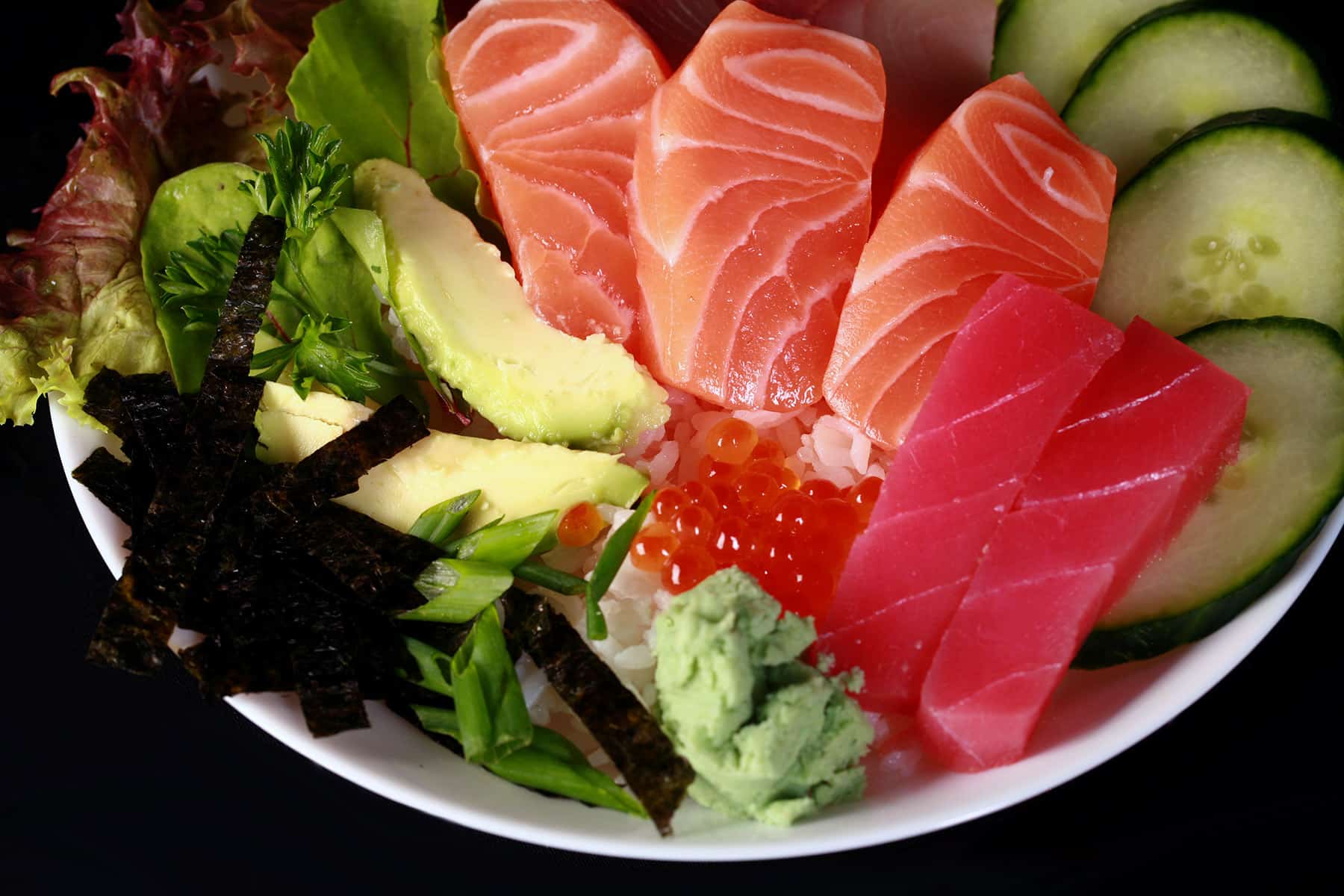
Keto Sushi Rice
While I love regular sushi rice, I’m needing to cut my carbs. An easy way for me to go low carb with sashimi bowls is to use ... anything other than white rice.
Usually, my go-to rice options are celery root (“Celeriac”), and cauliflower - both allow for keto -ifying otherwise carbby dishes.
Cauliflower wasn’t even an option for me until recently, as it was a HORRIBLE gout trigger for me for about 3 years - I’d loved it before that point!
Recently, I managed to cure my gout (knock on wood!), and cauliflower has made a VERY welcome reappearance on our menu. I missed it!
Given the choice between the two options, in general I prefer the celery root. I like the mild celery taste it adds to whatever I put on it, especially when we’re talking about things like buffalo chicken meatballs. It just works!
For this, I prefer the taste of cauliflower rice. I just find it works better with the sushi rice seasoning, a better pairing for it.
My full recipe for keto sushi rice is in the recipe card at the bottom of this post, but as a quick runthrough of what you’re looking at, you’ll:
Chop and then rice a small head of cauliflower.
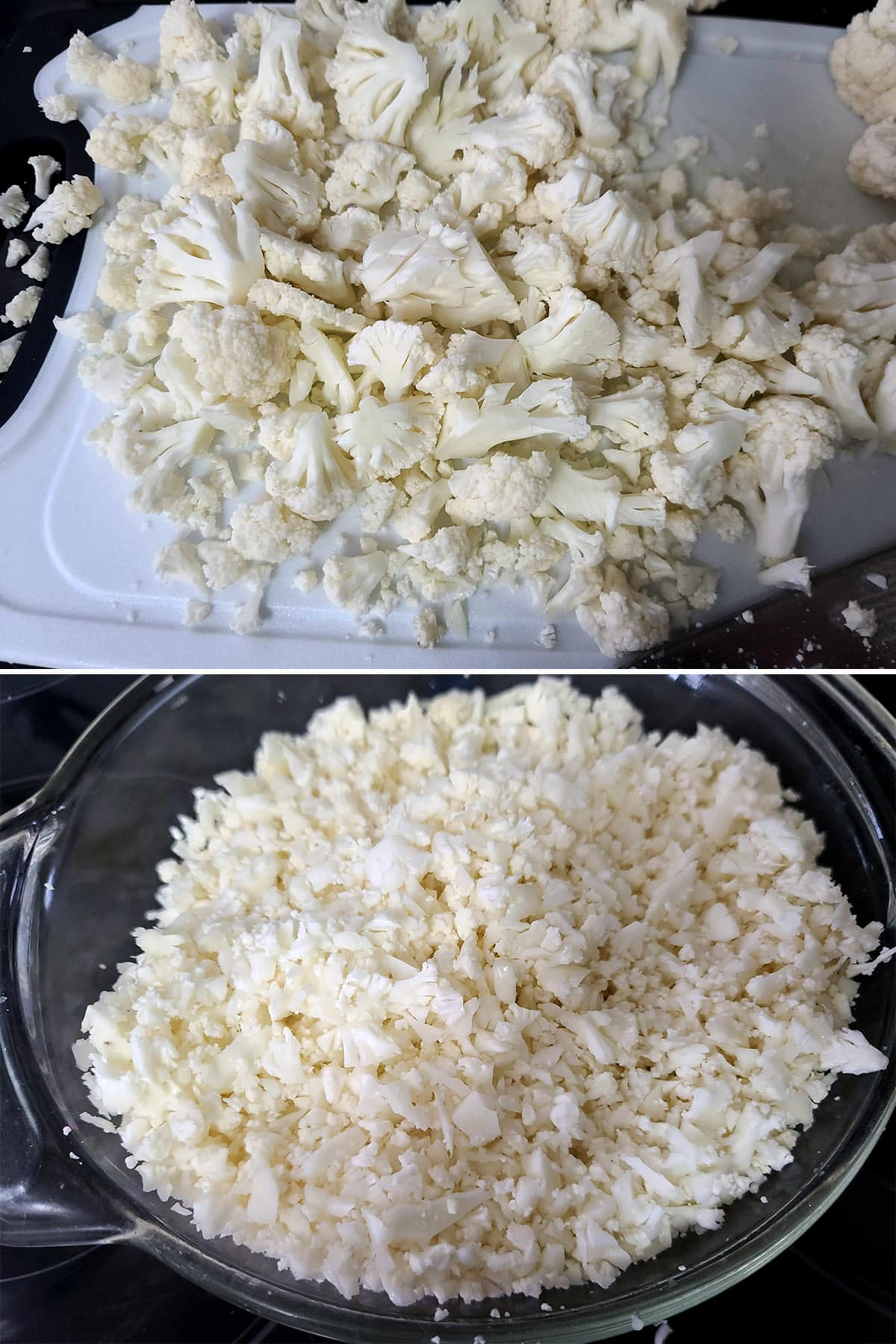
Cook in the microwave for a bit.
Mix together rice vinegar, sugar substitute, and salt, heat until dissolved.

Add the vinegar mix to the cauliflower. Stir, allow to cool a bit.
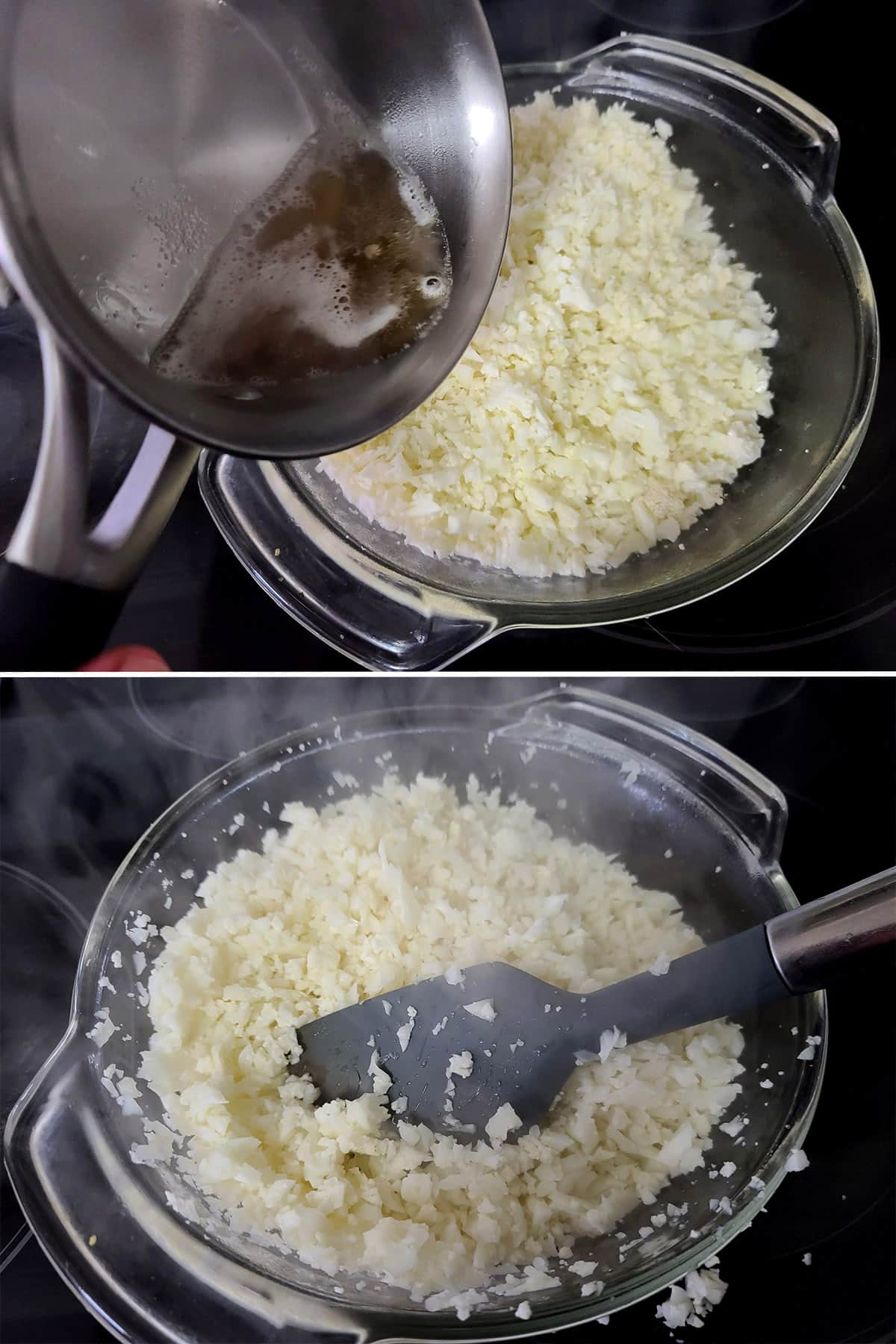
Finally, assemble your own chirashi bowl! Lay down your bed of rice, arrange delicious toppings as desired.
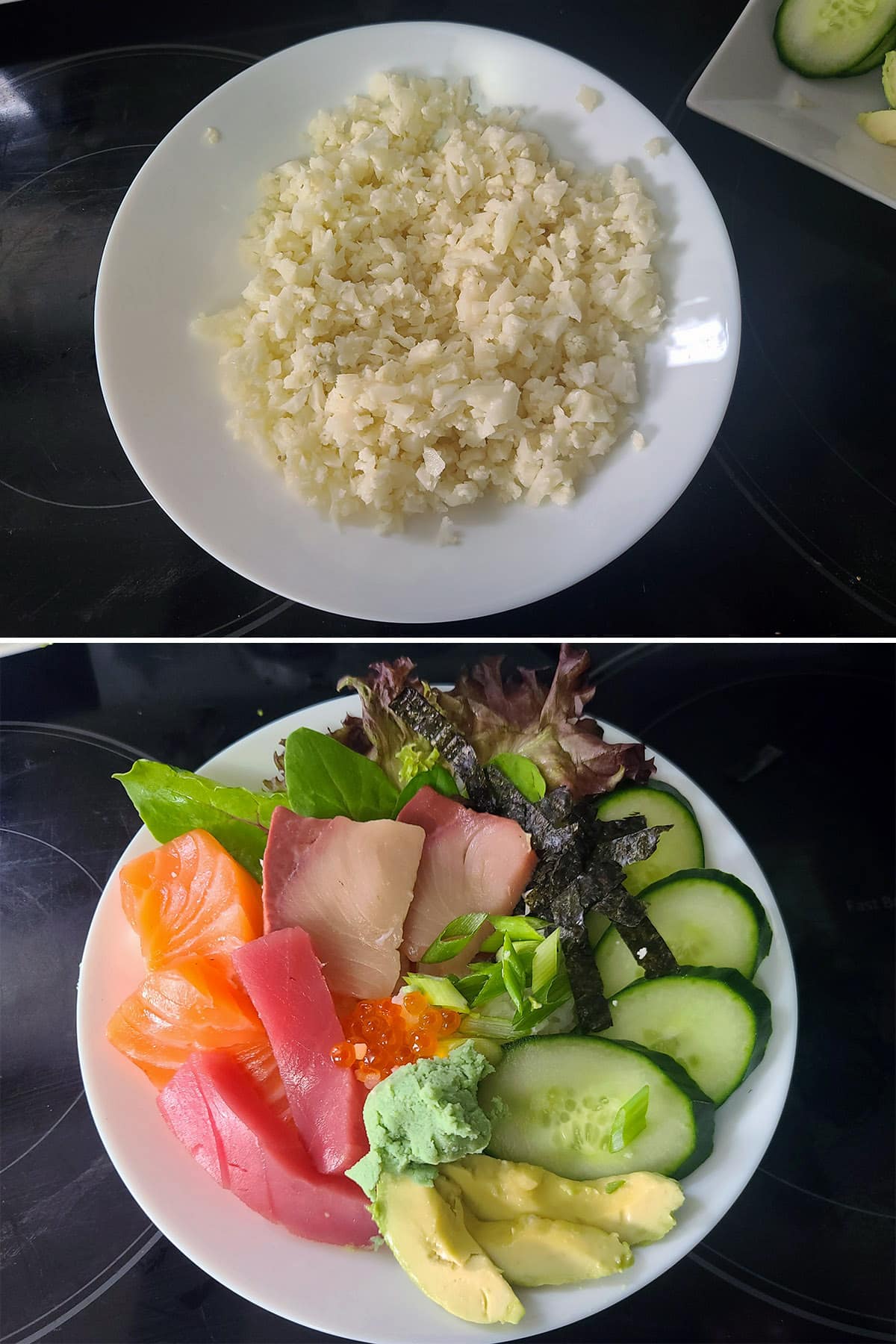
Paleo Chirashi / AIP Chirashi
If you’re following a paleo diet or the autoimmune protocol, you can still have chirashi!
Follow the directions for the keto sushi rice, but swap the rice vinegar out for apple cider vinegar, and the sugar substitute out for the same amount of honey.
Easy!
Protein
There are a few ways to get your protein in this dish.
Sashimi Grade Fish
As I previously mentioned, chirashi bowls generally feature a variety of beautiful slices of raw fish.
Raw tuna is our favorite. We tend to skip the fish market, and use the sashimi grade albacore tuna that we get from Skipper Otto.
Fatty tuna is always tasty, and can also be done up as Spicy Tuna with a little mayo and Sriracha.
Thin slices of salmon sashimi are always a pretty addition to the bowl.
Be sure to read my Tuna Mango Poke post for more details on food safety as it relates to finding sashimi grade fish at a fish market - and handling it.
Once you’re hooked up with some great fish, all you’ll need is a cutting board and a sharp knife.
I love my Sushi Knife, as it make cutting sashimi a breeze.
Bonus? It’s under $12!
The Big Cheat!
I don’t know if this is going to cost me “food blogger cred”, but let me tell you - there’s a great option to kind of cheat on the fish aspect of making home chirashi bowls, and I have no idea why I didn’t think of it earlier.
You see, finding sashimi-grade fish can be difficult for some... and that goes double when you’re needing to find a variety of different sashimi-grade fish.
Also, if you’re only making these Keto Chirashi Bowls for one or two people, it can be expensive to buy multiple pieces of fish.
Depending on the size of the fish purchased, this can also either create waste, or necessitate more than one meal of chirashi in a row. (Not necessarily a bad thing, IMHO*)
So we’ve taken to ordering a sashimi appetizer spread from sushi restaurants, as pickup orders.
We have our rice and vegetables prepared at home ahead of time, and go pick up the fish.
Letting the sushi chefs deal with the fish makes for a nice quick lunch option!
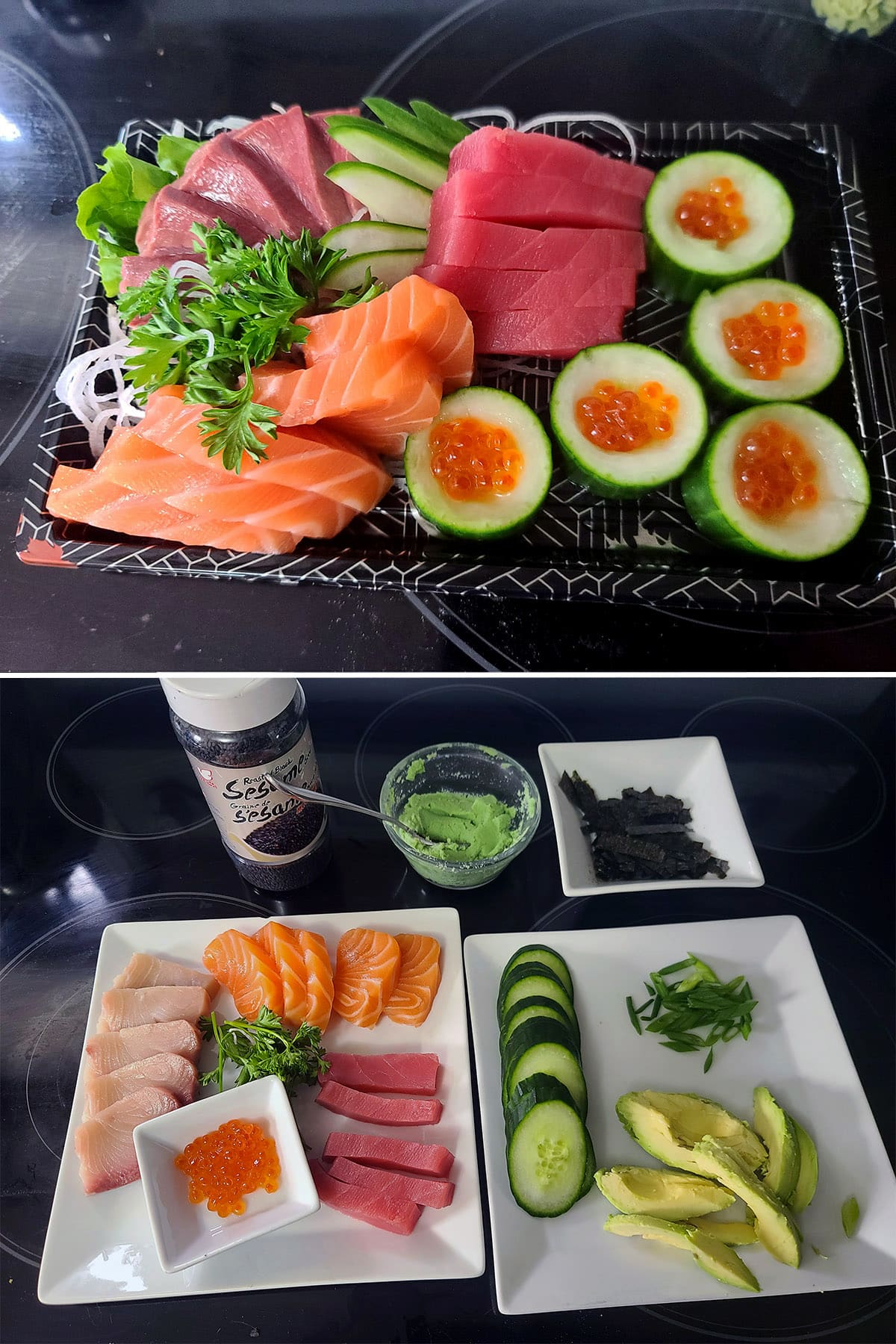
We get the perfect amount of sashimi-grade fish that’s been expertly handled, without having to mess around with defrosting or preparing it ourselves... and no waste.
LOVE IT.
We get to patronize a favourite restaurant, *and* still get a diet-friendly option that we want. Score!
* Whether we’re making chirashi, or buying it by itself, our spoiled cats are HUGE fans of salmon sashimi and tuna sashimi. We always have to order a couple of extra pieces, or they will not allow us to enjoy our meals in peace.
Absolute sushi monsters. They’re lucky they’re so cute!
Other Protein Sources
All that said, the protein doesn’t always end at raw fish / raw seafood!
Cooked shrimp, imitation crab sticks, and even thin omelette - sometimes shredded into “noodles”, as kinshi tamago - can be found in restaurant chirashi bowls.
With the possible exception of the “crab” stick - which can have a starch in it and be higher carb than you’d expect - it’s all naturally low carb and keto.
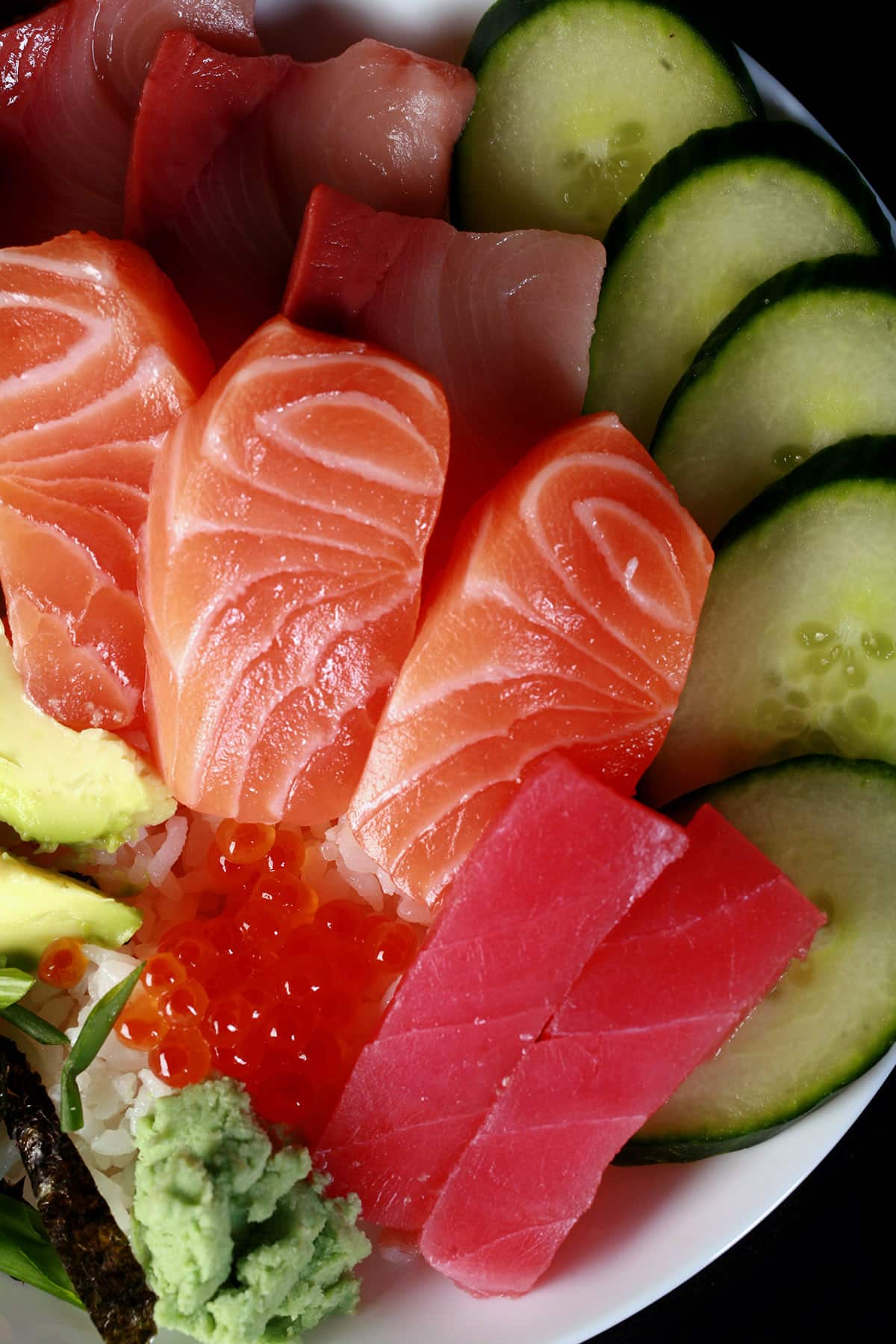
Vegetables
We tend to go fairly simple on the vegetables, while staying pretty well on “sushi” theme. Cucumber, avocado, edamame, radishes (usually watermelon radish), etc are common toppings, when we’re making chirashi.
Pickled daikon radish ribbons are also a great option, I just usually don’t bother unless I have some on hand.
Bamboo shoots are low in carbs, especially in the small quantity you’d be using. Shiitake mushrooms are another great option.
Depending on your macros, you can add snap peas or snow peas. Lotus root is really high in carbs, though!
Whatever you use, it’s good to have a variety of flavours and colours involved. This is very much an “Eat with your eyes first” deal.
Garnish
Again, we keep it pretty simple when garnishing this.
Usually, I’ll slice up some nori (seaweed sheets), add some, maybe shake some sesame seeds or furikake over it for good measure.
Note: Try my homemade Furikake Recipe!
Sakura denbu is a related topping - dried fish flakes.
We’ll use a bit of fish roe - usually masago, tobiko, or salmon roe - if we have it on hand. (Or order it with the sashimi!)
The only thing that I do with 100% consistency is include wasabi, because.. Really.
If you’re feeling bougie or just ~extra~ in general, you can always add some pretty fresh herbs or edible flowers.
Chirashi is all about presentation, after all!
Sauce
Unlike our Poke bowls, we we usually don’t bother with sauces for a chirashi bowl, beyond a bit of soy sauce / coconut aminos, and wasabi.
For some reason - and that reason could be “We have never had a sauce on sushi bar chirashi bowls” - it just feels wrong.
You do you, though.
Because it’s basically “sushi in a bowl” - if I were to do sauce - I’d stick to one of the commonly used sushi sauces, like Dynamite, Eel, or Mango Sauce.
Be sure to check the carb count when using sauces, if you’re aiming for a low carb!
That mango sauce is pretty carbby (but SO good!)
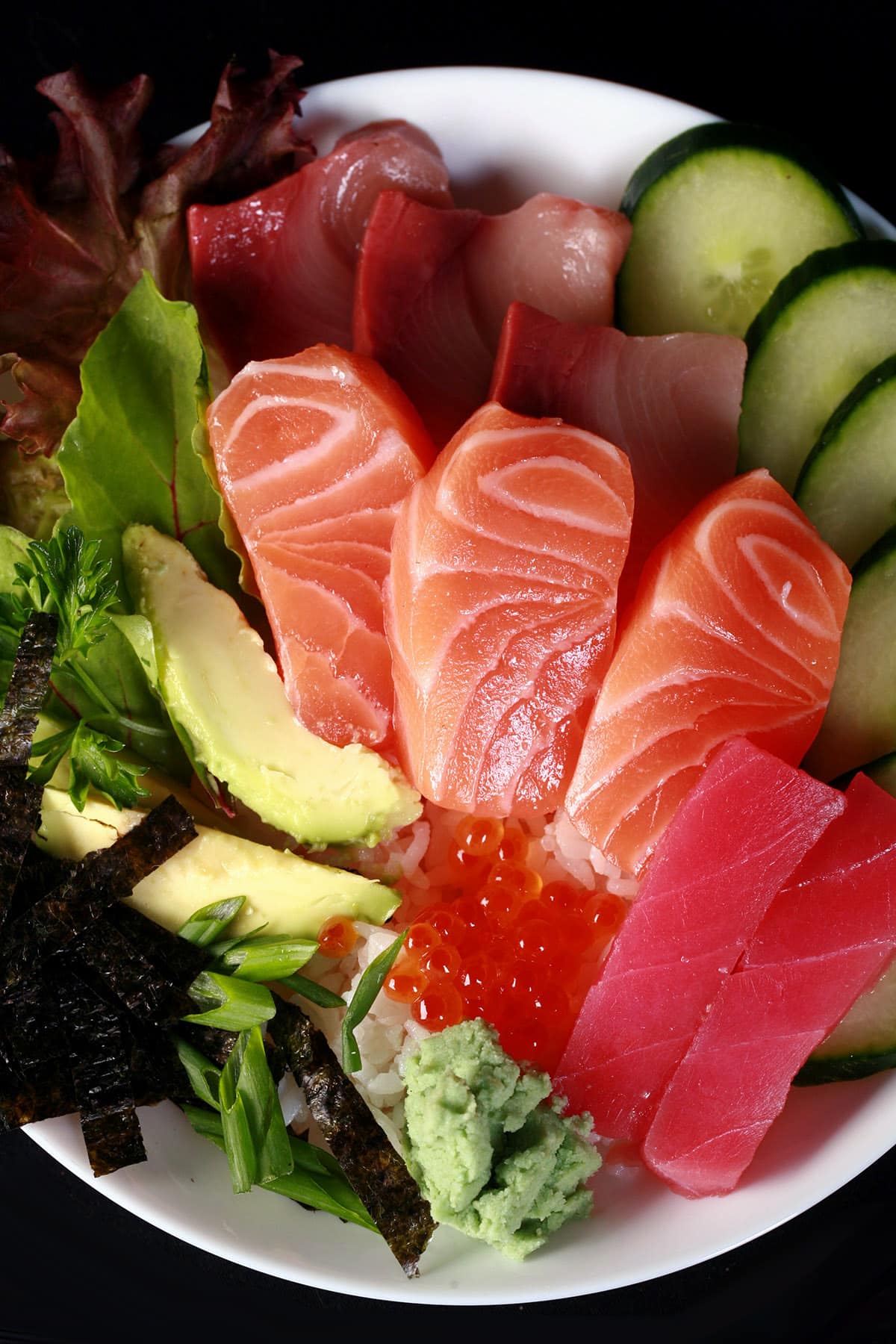
More Low Carb Fish & Seafood Recipes
Looking for more low carb or keto fish recipes? I’ve got you covered!
Ahi Tuna Crudo
Keto Spicy Salmon Poke Bowl
Grilled Cilantro Lime Shrimp
Keto Crab Cakes
Tuna Poke Bowl
Salmon Crudo
Keto Clam Chowder
Crunchy Keto Coconut Shrimp
Low Carb Shrimp Curry
Hot Smoked Sockeye Salmon
Keto Jambalaya
Pesto Shrimp Palmini
Low Carb Spinach Feta Salmon Pinwheels
Keto Sushi
Seared Scallops with Dijon Wine Sauce
Keto Cod au Gratin
Baked Sesame Ginger Salmon [Keto]
Keto Fish Cakes & Tartar Sauce

Share the Love!
Before you chow down, be sure to take some pics of your handiwork! If you post it to Bluesky, be sure to tag us - @CelebrationGen. We're also on Pinterest, so you can save all your favourite recipes to a board!
Also, be sure to subscribe to my free email newsletter, so you never miss out on any of my nonsense. Well, the published nonsense, anyway!
... and hey, if you love the recipe, please consider leaving a star rating and comment! (Sharing the post on social media is always appreciated, too!)
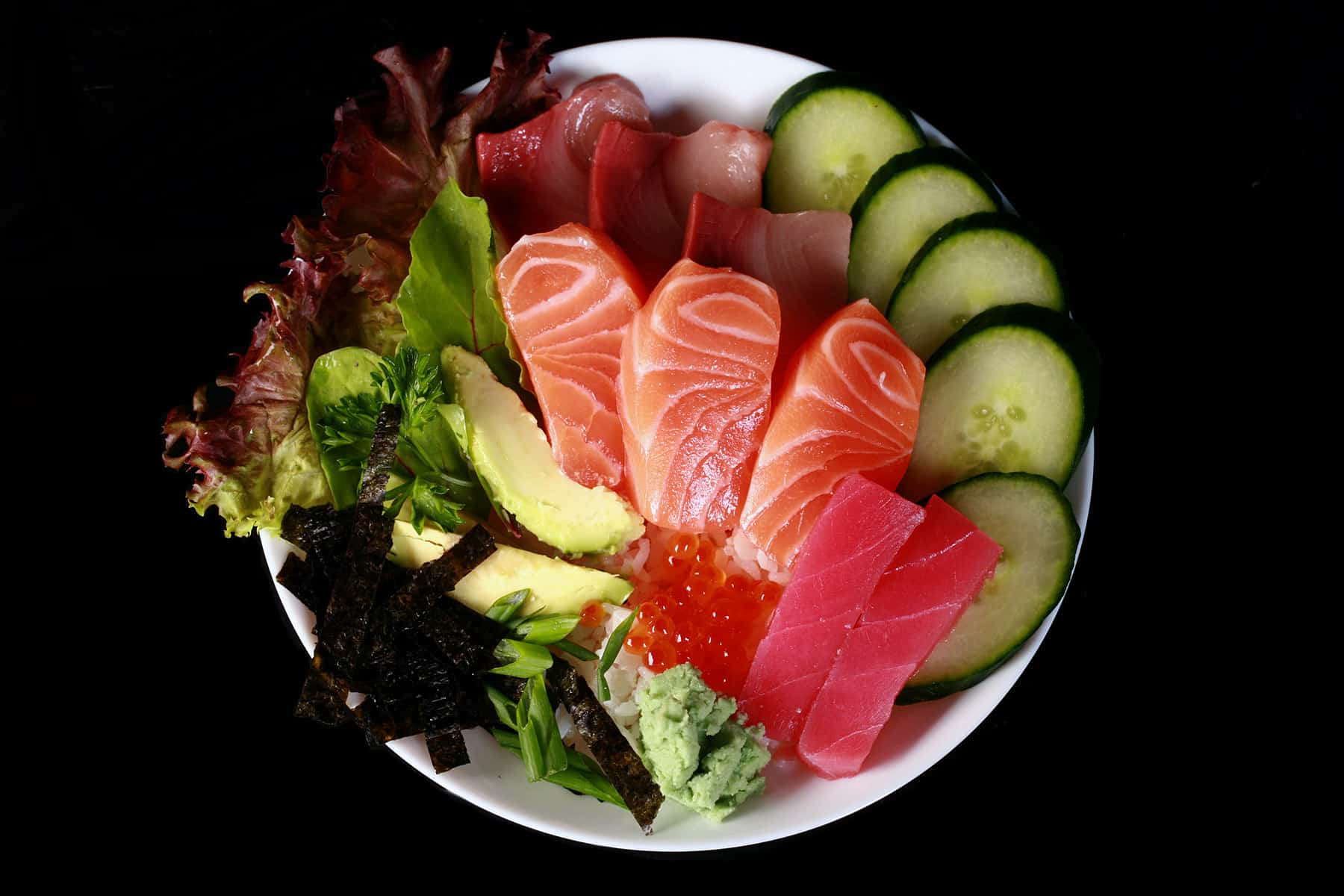
Chirashi Sushi [Chirashi Bowl]
Equipment
Ingredients
Keto Sushi “Rice” (or use Traditional Sushi Rice)
- 1 small head cauliflower
- 2 tablespoon Seasoned rice vinegar
- 2 teaspoon Sugar substitute
- ¾ teaspoon Salt
For Assembly:
- ½ lb Sashimi grade Fish slices
- Avocado
- English cucumber sliced
- Other vegetables, as desired
- Nori cut into small ribbons
- Sesame seeds
- Prepared Wasabi
- Other garnishes, as desired
To Serve:
- Soy Sauce
Instructions
For Low Carb Sushi “Rice”:
- Chop cauliflower into small florets, transfer to a food processor.
- Blitz until cauliflower resembles rice. Transfer to a microwave safe dish.
- Microwave for about 5 minutes - stirring every once in a while, until hot and cooked through.
- Mix together rice vinegar, sugar, and salt. Pour over hot “rice”, stir well to combine.
- Allow to cool to room temperature
To Assemble:
- Divide cooled “rice” between two bowls. (I like to use wide, shallow bowls for this).
- Arrange fish, vegetables, and any other garnishes on top of the rice.
- Sprinkle with sesame seeds.
- Serve immediately, with soy sauce
Video
Notes
Nutrition

Older Photos
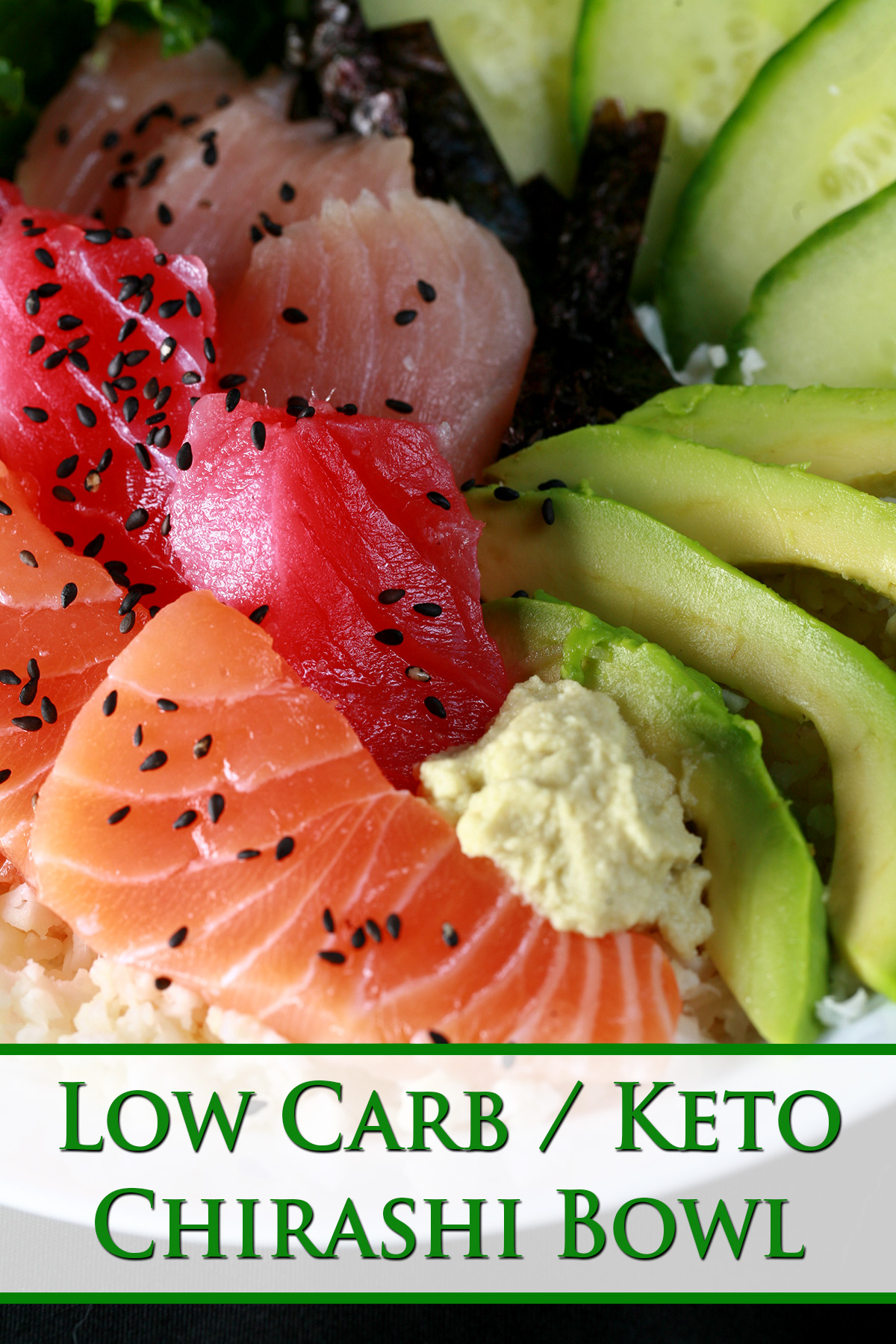




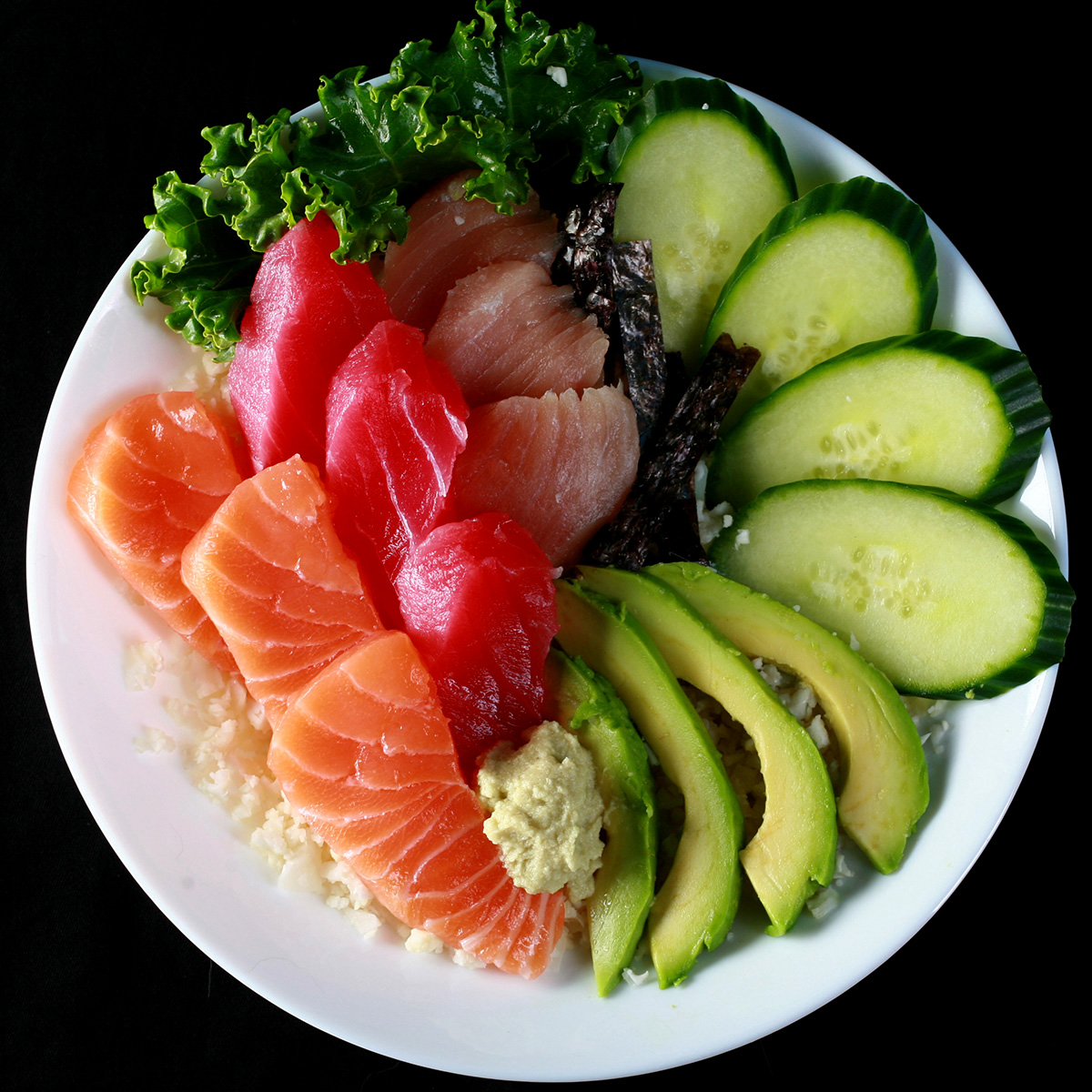

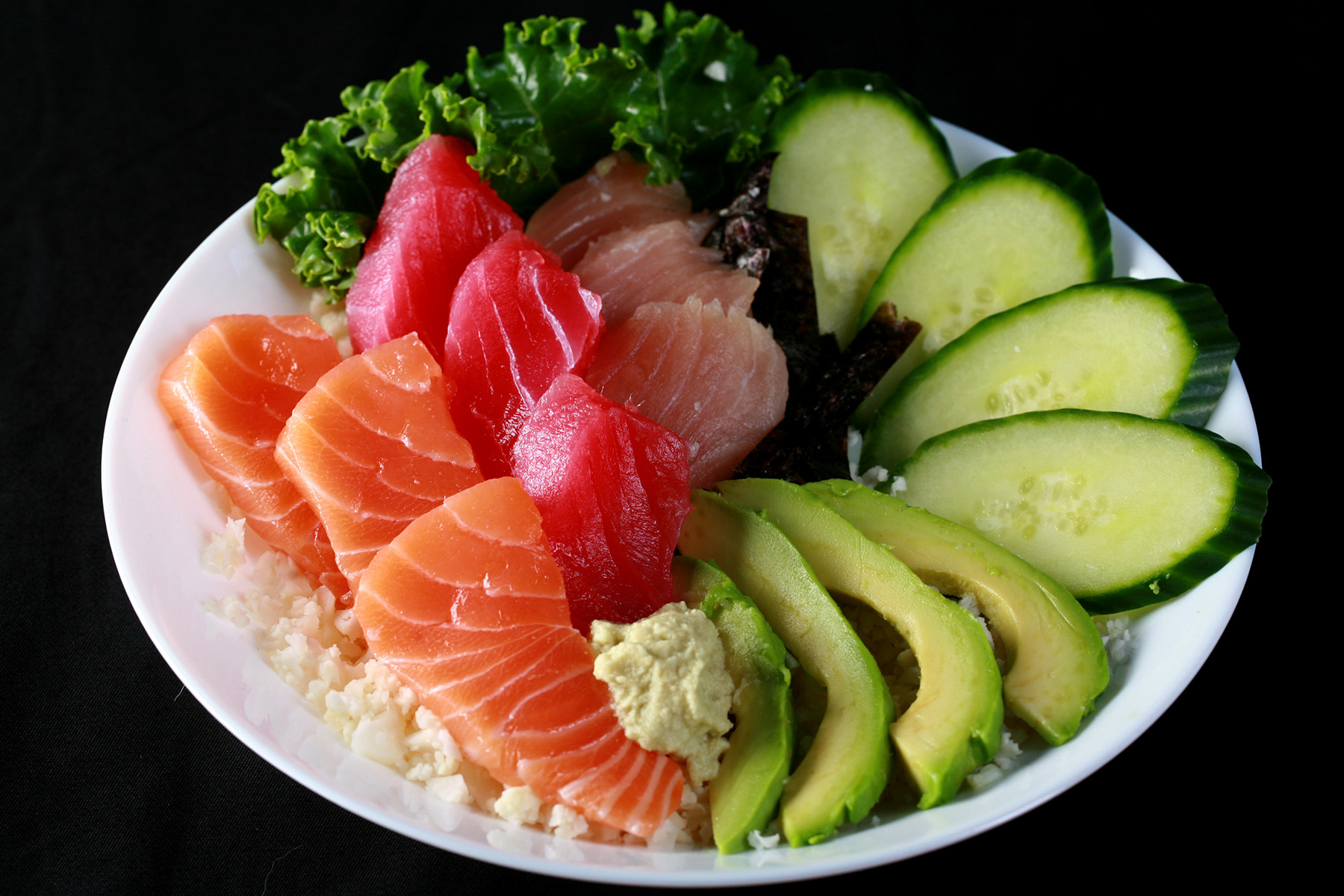

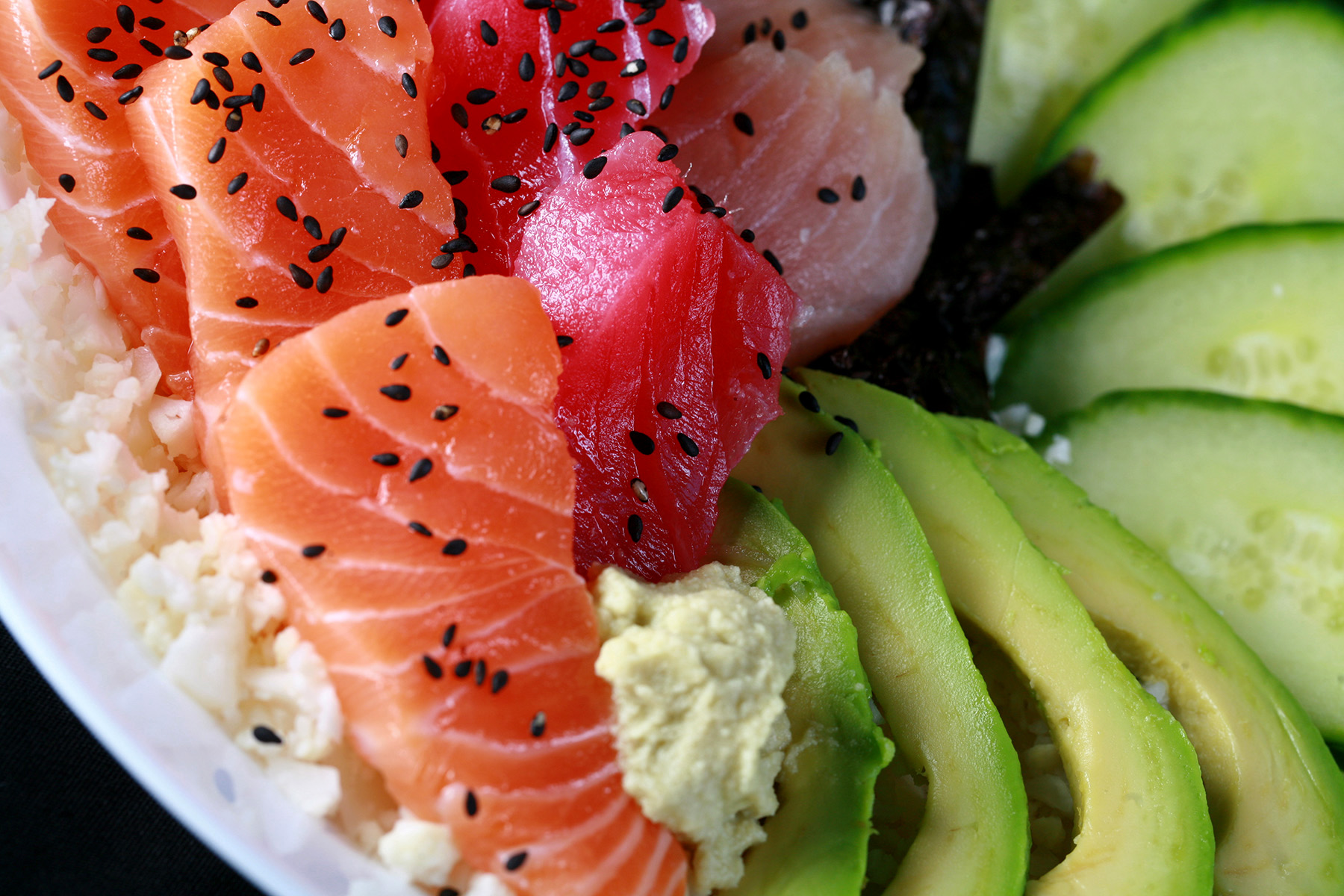
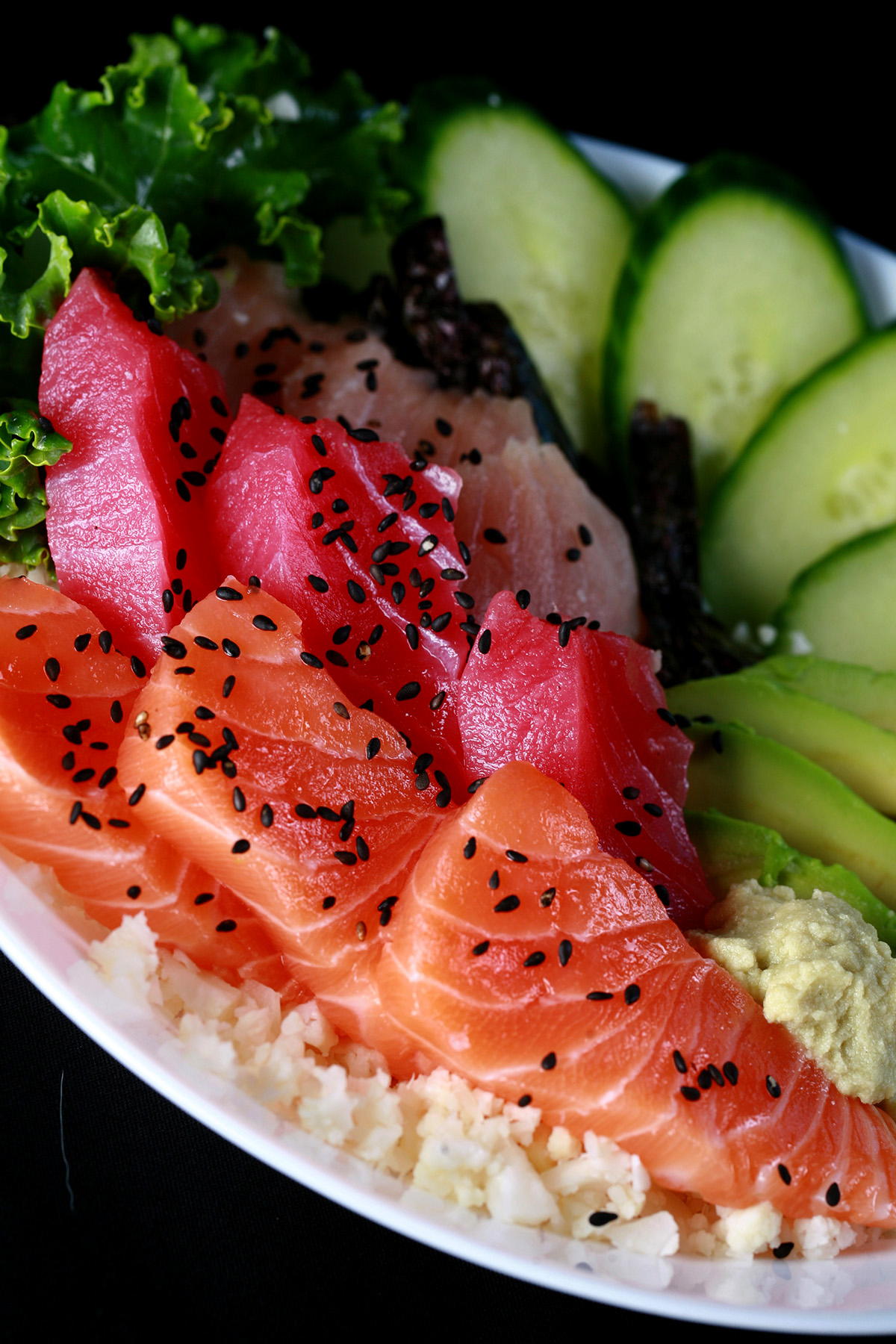



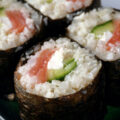
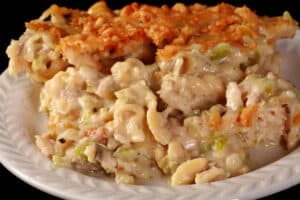

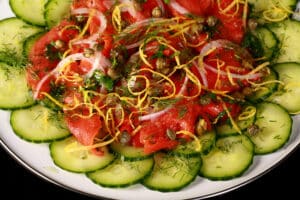
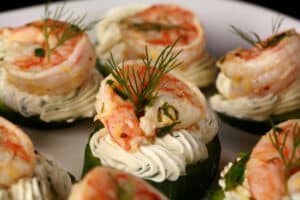
Yum! This is my favourite way to eat sushi!
I never considered chirashi sushi as being a possibility on AIP. I'm definitely going to have to try this!
I know I can use coconut aminos instead of soy sauce, but is wasabi considered AIP? I'm sure it's paleo?
Wasabi is AIP *IF* the brand you're using isn't full of non-AIP ingredients. Just the horseradish is fine, though!